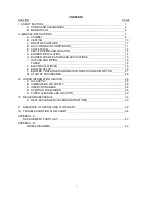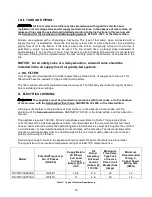
3
The entire text of these instructions must be read and understood, before
installing the appliance. It is the installer's responsibility to do the following:
1. Inform and demonstrate to the user, the correct operation and maintenance of the appliance, as
explained in the
Homeowner/User Information and Routine Maintenance
section of this manual.
2. Inform the user of the hazards of flammable liquids and vapors and to remove such liquids and
vapors from the vicinity of the appliance.
3. Inform the user of all pertinent warnings and precautions concerning this appliance.
WARNING: This unit is not to be used for temporary heating of buildings, or structures, under
construction.
Construction dust may enter the appliance or the duct system and cause a fire hazard.
Certain chemicals used during construction when burned, form corrosive condensate that can
substantially reduce the life of the heating system heat exchanger.
This appliance is shipped completely assembled and internally wired. All electrical wiring has been factory
installed and inspected. At the time of installation, the unit will require connection to electric power, fuel oil
supply, and supply and return air ductwork.
This unit uses a fan-assisted combustion system, consisting of a pressure atomizing, oil burner and
combustion air blower, used to push the products of combustion through the heat exchanger system.
After installation, the furnace and duct system must be adjusted to obtain a temperature rise of 56°- 81°F
through the unit. (Refer to the rating label located on side panel inside the burner compartment). The
installation must conform with local codes or, in the absence of local codes, with the Standard for the
Installation of Oil-Burning Equipment, NFPA 31-1997, or the latest edition, and to these instructions. The
installation must also comply with CSA B139 for recommended installation practices where applicable.
A. CODES AND CLEARANCES:
The following items must be considered when choosing the size and location of the unit.
1.
All local codes and/or regulations take precedence over the instructions in this manual and
should be followed accordingly.
In the absence of local codes, installation must conform to these
instructions and the guidelines of the National Fire Protection Association (NFPA). Two applicable
NFPA installation codes are the National Electrical Code, ANSI/NFPA 70-1999, and Standard for the
Installation of Oil-Burning Equipment, NFPA 31-1997. The latest editions of these codes should be
consulted.
2. The selection of a heating unit should be based on a rate of heat loss calculation for the residence
according to the manuals provided by the Air Conditioning Contractors of America (ACCA) or the
American Society of Heating, Refrigeration, and Air Conditioning Engineers (ASHRAE). The heating
capacity of the unit proposed for installation should meet or slightly exceed the rate of heat loss for the
residence. Over sizing should not exceed 25% of the heat loss calculation.
3. When installed, this unit should be level. If possible, it should be installed in a central location, with
respect to outlet registers of the supply air ductwork.
4. Definitions of "combustible" and "non-combustible" materials as presented in the 1996 version of the
National Fuel Gas Code, ANSI Z223.1-1996/NFPA 70-1996, are as follows:
a.
Combustible material:
“...materials made of or surfaced with wood, compressed paper, plant fibers, or
other materials that are capable of being ignited and burned. Such materials
shall be considered combustible even though flame proofed, fire-retardant
treated, or plastered.”
Summary of Contents for THV1M119A960SA
Page 2: ......
Page 4: ......
Page 6: ...2...
Page 36: ...32 V Sequence of Operations Flow Chart...
Page 37: ...33...
Page 38: ...34 VI Trouble Shooting Flow Chart...
Page 39: ...35...
Page 40: ...36...
Page 41: ...37...
Page 42: ...38...
Page 44: ...40 Appendix A Replacement Parts for THV1M119A...
Page 45: ...41...
Page 46: ...42 Appendix B THV1M119A960SA PSC Wiring Diagram...








































